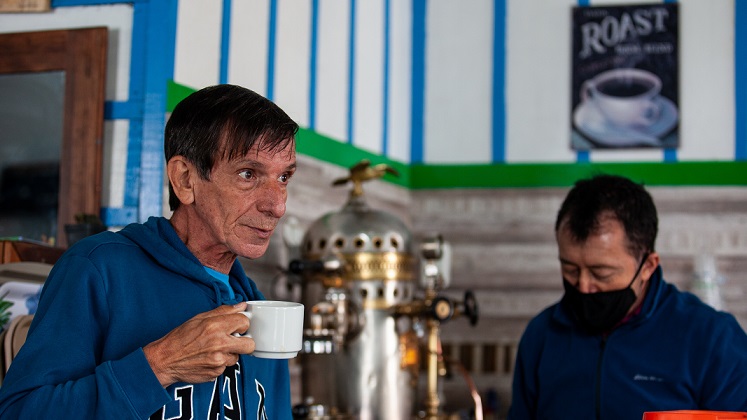
 By providing the option of working in town, bridges allow villagers to generate income even when times are bad, thereby freeing up resources to be spent on productive farm activities, write Wyatt Brooks (Arizona State University) and Kevin Donovan (Yale University).
By providing the option of working in town, bridges allow villagers to generate income even when times are bad, thereby freeing up resources to be spent on productive farm activities, write Wyatt Brooks (Arizona State University) and Kevin Donovan (Yale University).
One of the fundamental features of lower-income countries is the low productivity of isolated, rural areas. In Nicaragua, as elsewhere in the tropics, these problems are exacerbated by the potential for flooding during the rainy season. International organisations and community leaders alike have identified this weather-driven isolation as a key constraint on the country’s development.
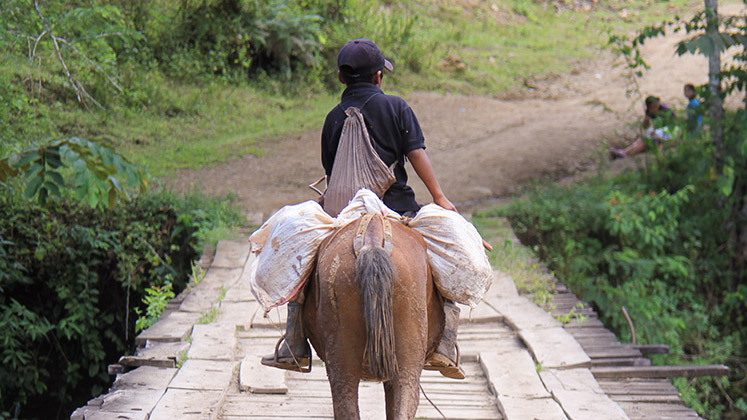
To what extent can new infrastructure solve this problem? And if it can, by what channels is this progress achieved? These are important questions, because the high cost of building new infrastructure requires a careful delineation of potential benefits. Yet these same costs make this a particularly difficult topic to study. Since high cost programs tend to be high profile, they also tend to incentivise placement in areas selected to maximise benefits. Placing infrastructure in strategic locations based on potential gains is a natural and sensible strategy, but it does also make it extremely difficult for any analysis to disentangle the impact of the location from the impact of the new infrastructure itself.
By teaming up with the NGO Bridges to Prosperity (B2P), however, our research was able to overcome these obstacles and provide a clearer answer on the impacts of new infrastructure. B2P builds footbridges that cross potentially flooded rivers, eliminating the risk that rural villages will suddenly find themselves cut off from the health clinics, schools, and peri-urban markets to which they usually enjoy access.
Flooding in northern Nicaragua
Nicaragua is subject to seasonal rains from May to November. These rains flood nearby rivers and prevent villagers from accessing better paid day-labouring jobs in nearby towns. While flooding is not continuous, it is frequent.
In our study in the northern departments of Estelí and Matagalpa, the average village experiences at least one day of flooding in nearly half of the weeks in the rainy season. When floods do occur, they last for an average of five days. These torrents of water, driven by rainfall higher up in the mountains, induce extremely dangerous crossing conditions. However, when riverbeds are not flooded, they are easily crossed on foot, on horseback, or by vehicle.
Using bi-weekly data collected from villagers over the course of two years, we find that floods have a large negative effect on earnings from wage work. Specifically, a flood lowers wage earnings by 18%, while it increases the likelihood of earning no wage income from 24.9% to 31% compared to a week without a flood (as illustrated below).
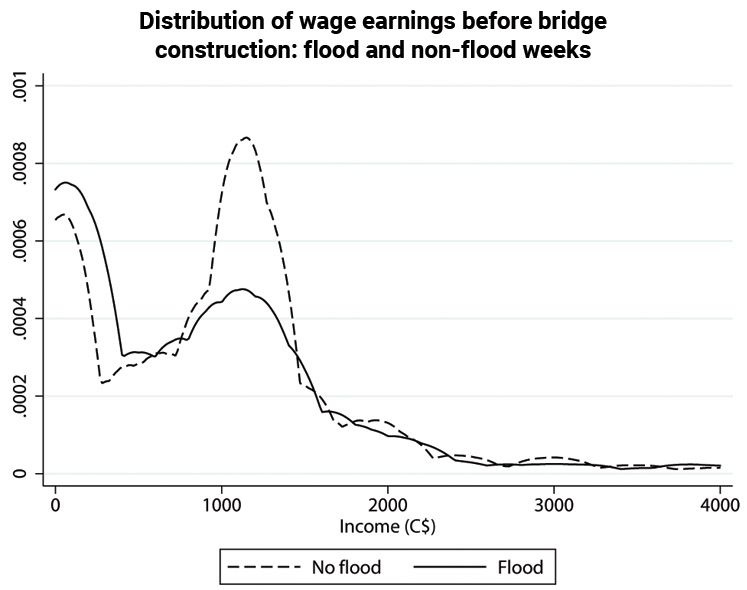
Yet this is unlikely to be the full story, as the second graph (below) reveals. Despite the fact that these are farming communities, nearly all households have at least some non-farm wage income. Thus, changing access to wage opportunities may simultaneously change farming outcomes by easing credit constraints or providing alternative income streams in the event of a bad harvest.
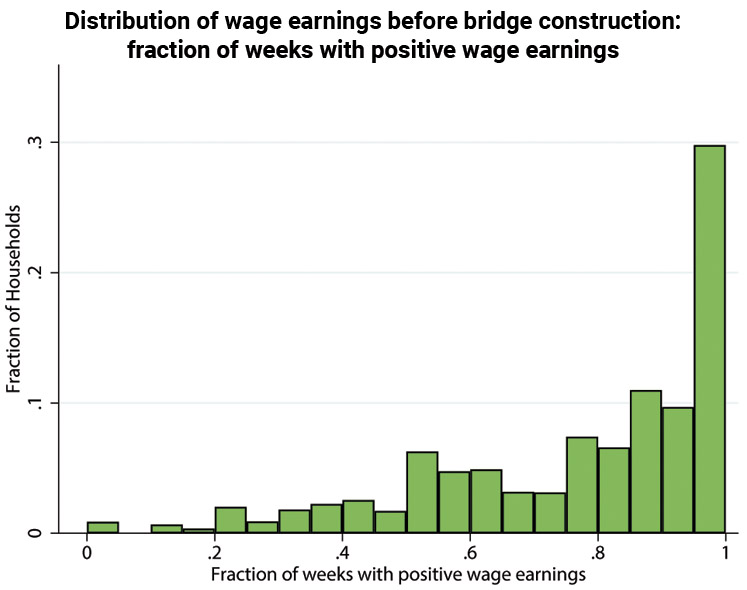
Bridges to Prosperity
By partnering with the NGO Bridges to Prosperity (B2P) to build footbridges over flood-prone riverbeds, we were able to study the cost of inaccessible urban markets. B2P’s bridges are technically sophisticated, resilient structures that can hold people, cattle, motorcycles, and carts without risk of failure during flash floods. Because of our participation in the construction process, we were able to collect three years of data, starting a year before the bridges were built. This included data on agricultural production, wage earnings, asset holdings, occupational composition, and other attributes that are generally very difficult to collect in such studies.
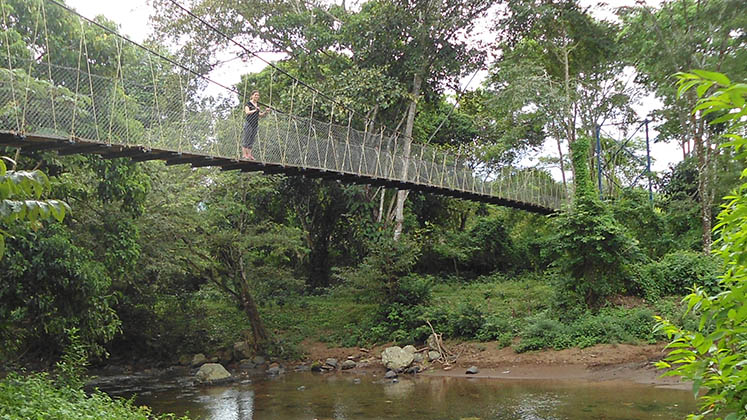
We compare villages that received a bridge with other villages that needed a bridge but where construction was infeasible due to particular characteristics of the riverbed (such as unevenness or width). Crucially, we show that these small topographical features are unrelated to any characteristics in the village, thereby allowing us to interpret any changes between these villages as the causal effect of the bridge.
Market access risk and local spillovers
Our results showed that these bridges did indeed mitigate the risk of accessing towns, as the introduction of a bridge eliminated the aforementioned 18% decline in wage earnings during floods. This is particularly important given that urban daily wages for men, who do the majority of urban labour work, are approximately 30% higher than wages in rural areas. The difference that a bridge can make is clear in the graph below: once a bridge is constructed, the distributions of earnings become quite similar during flood and non-flood weeks.

While the direct effect on earnings is interesting in its own right, it is not the only benefit. First, the movement of some villagers toward higher paying jobs outside the village put upward pressure on the local wage. In fact, the average wage gap between the village and the nearby town was eliminated with the introduction of a bridge. Aside from allowing some villagers to access higher wage jobs, the bridge also led to higher induced wages in the village, meaning that those who stayed also reaped the benefits of their neighbours leaving.
The second spillover effect was on the farm, where fertiliser expenditures increased by 63%. At the same time, farm profit increased by 74%. It is worth underlining this point: despite the fact that expenditures on the two main inputs increased – there is little capital use in these villages – profit still increased by 74%. This implies that there was some economically significant constraint holding farmers back; once this constraint was removed by a newly built bridge, harvests and revenue increased more than costs.
Self-Insurance via labour markets
What are the underlying mechanisms generating these results? The most intuitive explanation is that bridges lowered trade costs, allowing farmers cheaper access to fertiliser or higher sale prices for crops. However, this is not the case in our context. Since the rainy season overlaps with the cropping season, fertiliser is purchased pre-rain whereas the harvest is sold post-rain. As such, neither is subject to this risk.
We instead show that the increase in farm profit is closely linked to the ability to access new labour markets. In particular, the option to work in town allows villagers to generate income when times are bad, thereby freeing up resources previously held as precautionary savings to be spent on productive farm activities. Indeed, we find that farmers decrease the fraction of their harvest stored for their own consumption from 90% to 80%. Infrastructure, therefore, facilitates self-insurance and unlocks more productive investments on the farm.
Cost-effectiveness and looking toward the future
How important are these effects? Our results imply that the average bridge generates a 19% internal rate of return (IRR). At a cost of US$40,000 per bridge, these bridges pay for themselves in about 5.5 years. Thus, this type of infrastructure is cost-effective and compares favourably to some of the more successful recent interventions measured by cost-effectiveness. The spillover effects highlighted here are critical to this calculation. Fully one third of this 19% IRR is due to the increase in farm profit alone, and not capturing this margin would severely underestimate the impact of the bridges in our study.
There is also a broader message to take from these results. Although our study focused on the interaction between labour market access and agricultural outcomes, there are still numerous facets of rural life that require greater study. Women that we surveyed, for example, consistently highlighted issues of maternal health as a key benefit from these bridges, but our sample size limited our ability to investigate further. Accounting for the full effect of infrastructure requires a deep understanding of these various channels, along with the effects induced on the markets to which these villages connect.
These are big questions, and they require interventions at a macro scale, as the work of initiatives like Y-RISE and STEG has highlighted. Our own work with Bridges to Prosperity continues, and as we begin to study the same bridges on a much larger scale we aim to provide an ever more complete picture of the impact that infrastructure can have on rural communities.
Notes:
• The views expressed here are of the authors rather than the Centre or the LSE
• This piece draws on the authors’ article Eliminating Uncertainty in Market Access: The Impact of New Bridges In Rural Nicaragua (Econometrica, 2020)
• Please read our Comments Policy before commenting



